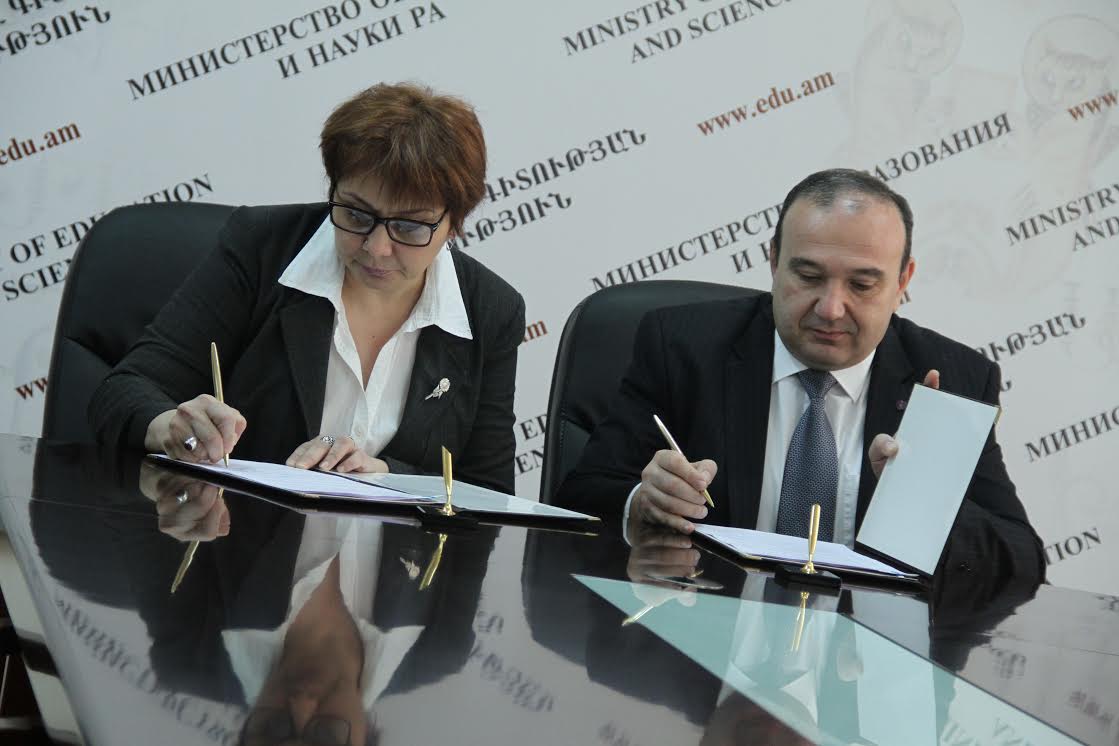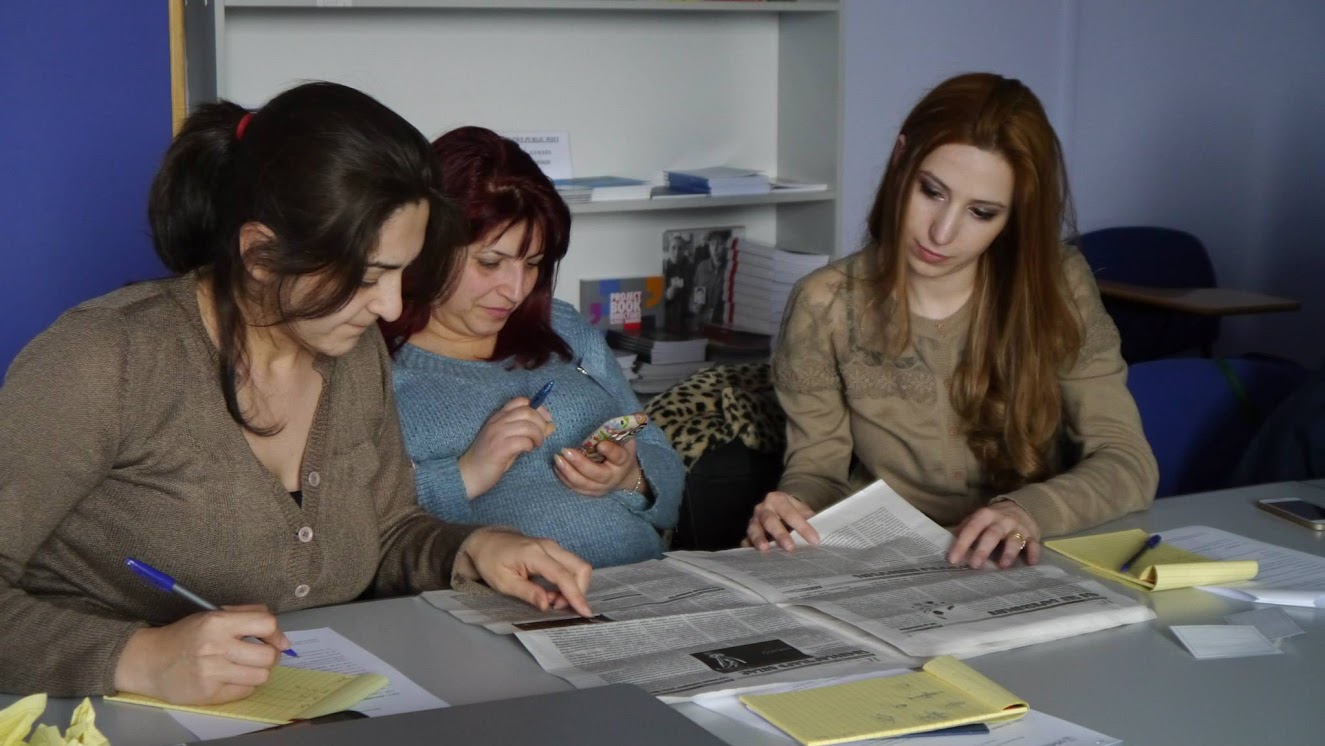
Armenia’s Ministry of Education and Science and the Media Initiatives Center (MIC) [responsible for this site] on April 19 signed a memorandum of cooperation to disseminate media literacy in the areas of public and higher education. It can be said that with this move the parties formalized the already years-long cooperation.
Approved by the Ministry in 2013, the Media Literacy Handbook produced by the Media Initiatives Center (at the time Internews Media Support NGO) helps teachers understand and then pass on to students what media is, how it works, how to navigate the stream of information today, and how to consume any media product critically.
About 300 teachers and librarians have already undergone the media literacy training program and received the handbook, which many of them use at school.

Karine Samvelyan is the physics teacher and vice-principal at Yerevan’s Andrei Sakharov School No. 69. Five years ago, she participated in the media literacy training program, and she brought the already third generation of media literacy students to visit MIC. In her words, the students like to talk about the media, discuss examples, create their own news, and better understand the world of journalism.
But media literacy is not yet a subject in schools, and if we consider the overloaded school curriculum, in the best case scenario it may become an elective course in high school.
The memorandum stipulates including media literacy in the existing subjects, specifically in social studies (topics and materials from the handbook have already been incorporated into the 9th grade textbook Social Studies [Harutyunyan, Gyulbudaghyan]), as well as making it a component of mandatory training for teachers and principals.
MIC shares the skills to understand the media in various formats: videos, games, an interactive museum, student contest, summer schools, and short courses. The program is taught in the eight Infotuns (MIC’s partners in the regions) operating in the regions and in the Children of Armenia Fund’s seven SMART rooms in Lori and Tavush marzer (provinces).

But our purpose is to turn this type of literacy into part of general education. In an educational system that encourages the use of information technologies in school, missing is the skill to analyze and assess the content transmitted through those technologies.
When searching for an answer to a question, children first of all won’t go to a library to search for the information in an encyclopedia but will ask, for instance, Google, and from the results, they will decide what to believe. Research shows that young people are often unable to make the right choice. According to a poll by the National Association of Schoolmasters Union of Women Teachers in the UK, 35% of teachers say that students cited false information they found online in their homework.
And a Stanford University study found that students had a hard time distinguishing fake information or advertising from news articles.
“Many people assume that because young people are fluent in social media they are equally perceptive about what they find there. Our work shows the opposite to be true,“ said Sam Wineburg, the lead author of the report.
The Programme for International Student Assessment (PISA), which tests students’ literacy, from 2018 will begin to test also the skills of critical thinking and navigating streams of information.
“Distinguishing what is true from what is not true is a critical skill today. Exposing fake news, even being aware that there is something like fake news, that there is something that is written that is not necessarily true, that you have to question, think critically. That is very important,” said Organisation for Economic Co-operation and Development’s education lead Andreas Schleicher ahead of the Global Education and Skills Forum in Dubai. Schleicher is also the person responsible for the PISA tests checking students’ literacy.

Bringing media literacy to schools is an international trend. Discussions became more pronounced particularly after Brexit and the US presidential elections in 2016. Discussions on “alternative facts” and “post-truth” reminded us that people are unable to navigate the information space even in countries where media literacy is included in educational documents and programs.
A free online media literacy course is available at Coursera, where the best universities offer various courses. And the American The News Literacy Project has created a free online module, which teachers can use to teach their students news literacy.
This is a vital issue also for professional media: so that their work is appreciated, media outlets also have to help people distinguish quality journalism from ethically flawed, unverified, fake, and misleading information. The News Literacy Project, for instance, is supported by more than 30 US media outlets, whose journalists voluntarily teach courses at schools.
While The New York Times creates educational resources and lesson plans for teachers.
Journalists’ participation is important also in terms of addressing the shortage of educators. To provide a long-term solution to the problem of professionals, MIC cooperates with Armenian universities, trying to integrate media literacy into teachers’ education.
Currently, the methodology of media literacy is taught at the Armenian State Pedagogical University’s Faculty of Culture, and it’s part of the Communication Skills subject at the Yerevan State Institute of Theatre and Cinematography. It has also been taught at Yerevan Brusov State Linguistic University’s Chair of Pedagogy.
To carry out the program in the past five years, MIC invited schools and universities, as well as libraries, museums, media outlets, and NGOs, to join in spreading media literacy in Armenia.
The signing of the April 19 memorandum was an important step toward making the process more coordinated and perhaps also more effective, so that upon graduation, students will be a little more literate as media consumers or, put differently, when reading, watching, or listening to any media product, they will know how to check its “expiry date” and “ingredients.”
Lusine Grigoryan
The views expressed in the column are those of the author's and do not necessarily reflect the views of Media.am.


Add new comment
Comments by Media.am readers become public after moderation. We urge our readers not to leave anonymous comments. It’s always nice to know with whom one is speaking.
We do not publish comments that contain profanities, non-normative lexicon, personal attacks or threats. We do not publish comments that spread hate.